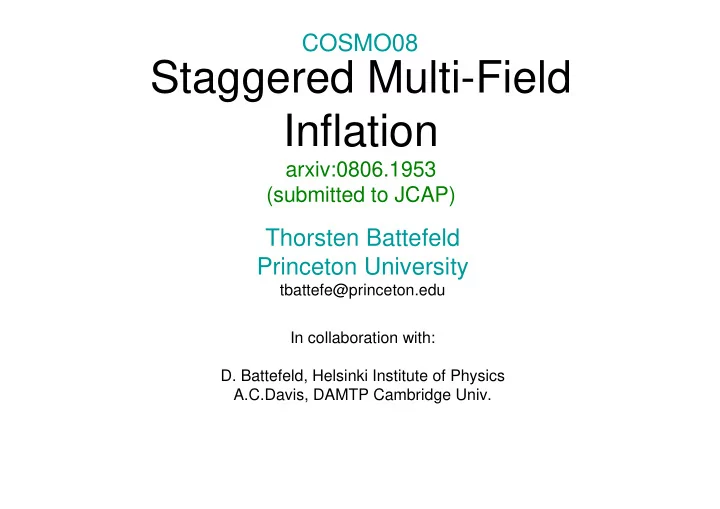

COSMO08 Staggered Multi-Field Inflation arxiv:0806.1953 (submitted to JCAP) Thorsten Battefeld Princeton University tbattefe@princeton.edu In collaboration with: D. Battefeld, Helsinki Institute of Physics A.C.Davis, DAMTP Cambridge Univ.
Review: Wands 07 Why are multi-field models interesting? “Natural” in string theory: many moduli fields are present. Assisted inflation effect (Liddle, Mazumdar and Schunck 98): - possible avoidance of super-Planckian field values - increased Hubble friction, steeper potentials work, reduced fine tuning Many open issues (good for theorists): - implementing concrete models in string theory (active field) - staggered inflation effect (new, this talk) - largely unknown theory or (p)re-heating (danger of heating hidden sectors D. Greene 08, potentially no parametric resonance D. Battefeld, S. Kawai 08; see also talk of J. Braden, … - possibly large non-Gaussianities (model dependent, see review Wands 07)
Main Question What are the consequences if fields drop out of multi-field inflation in a staggered fashion? This is a generic feature in many models of multi-field inflation in string theory. E.g. in: • Inflation from multiple tachyons Majumdar, Davis 03 • Inflation from multiple M5-branes Becker, Becker, Krause 05 • …
Outline 1.Concrete examples of multi-field inflation within string theory. 2.Analytic formalism to compute effects due to staggered inflation - background (relation to warm inflation) - perturbations (adiabatic and isocurvature) - scalar spectral index - extensions (several follow up projects possible) 3.Application - inflation from tachyons 4.Conclusions Note: throughout
Example: Inflation from M5-branes (BBK setup) Becker, Becker, Krause 05 Consider Orbifold: Orbifold fixed planes Interbane distance inflatons; Result: assisted inflation … N M5-branes Branes dissolve into Boundary branes during inflation, one after the other, fields drops out of the model; energy is converted, e.g. into radiation. Result: N(t) decreasing during inflation. … Numerical treatment: Branes collide and dissolve, one after the other: staggered inflation (cascade inflation). Ashoorioon, Krause,06
Example: Inflation from multiple tachyons Majumdar, Davis 03 N D-brane/antibrane pairs give Potential (trustworthy near origin): rise to U(N)xU(N) sym.: N^2 coupled tachyons, M.&D. focus on abelian part: N, uncoupled fields. Review: K. Ohmori 01 Result: assisted inflation But: Fluctuation (e.g. QM) Condensation (sudden): field drops out of model, its energy is converted, e.g. into radiation. One field after the other drops out, N(t) decreasing during inflation: Staggered Inflation
D.Battefeld, T.Battefeld, A.C.Davis 08 Analytic Formalism to deal with fields dropping out: Smooth out N(t) and introduce a continuous decay rate: The rate is model dependent and can depend on time. For this smoothing to be a good approximation, we need that in any given Hubble time of interest several fields drop out. Further simplifying assumptions (not crucial): - uncoupled fields - identical potentials - identical initial conditions Effects we recover: - additional decrease of energy that drives inflation - additional, leading order contributions to observables (e.g. scalar spectral index) Effects we do not recover: - sharp steps in observables such as the scalar spectral index - ringing in the spectrum
Background evolution Introduce effective single field: Energy transfer to additional component: See Watson, Perry, Kane, Adams 06 for related work on a relaxing CC. Introduce small parameters: Can show that within inflationary models of interest to first order in small parameters:
Background evolution We get This leads to a scaling solution during inflation. Then the effective single field evolves according to Resembles warm Inflation (Barera 95), but - the radiation-bath originates from transferring potential energy, not kinetic - model can arise in string theory - avoids many problems of regular warm inflation Next, perturbations; new effects due to - presence of and perturbations therein - additional decrease of W due to the decay rate
Review: Mukhanov, Feldman, Brandenberger 92 Perturbations (straightforward) We can show that isocurvature/entropy perturbations are suppressed (follow Malik, Wands, Ungarelli 03, …), so we can focus on adiabatic perturbations. Use the Mukhanov variable, satisfying Where Focus on large scales, so Imposing QM initial conditions and using the background solutions, we can compute the curvature perturbation and the power-spectrum:
Perturbations The scalar spectral index becomes Recover known limits: • Usual slow roll: • Dynamically relaxing CC (Inflation without Inflatons): Watson, Perry, Kane, Adams 06 .
Summary of the Formalism The expressions for the scalar spectral index (and running) are general, but rely on the smoothing (time averaging) of N(t), assuming slow roll and for simplicity identical, uncoupled field potentials and identical initial field values.
Application: inflation from tachyons Majumdar, Davis 03 Consider Cases: Discuss these cases only, assuming • Exponential decrease of N: negligible slow roll contributions, that is assuming that the fields are very close to the origin – this is • Serial condensation: actually the best motivated case. (for inclusion of slow roll contributions and application to different setups, • Condensation all at once (unlikely): see arxiv:0806.1953)
Application: inflation from tachyons 1. Exponential condensation: We need around N=60 e-folds of inflation: Inflation ends once so that Further Applying the general formula for the scalar spectral index: Within 1 sigma of WMAP5. If we set we need
Application: inflation from tachyons 2. serial condensation: We need around 60 e-folds of inflation: Inflation ends once so that Further Applying the general formula for the scalar spectral index: Close to 1 sigma boundary of WMAP5. If we set we need
Conclusions Staggered inflation occurs naturally in several multi-field models within string theory. We developed the formalism to compute effects on some observables (scalar spectral index, running). Many possible follow up projects - relax the simplifying assumptions (initial conditions, type of potential, …) - compute tensor modes, Non-Gaussianities, … - revisit other existing models - compare with full numerical studies - construct new models based on staggered inflation effect (remark: hilltop potentials are feasible as long as rolling of the hill is possible classically).
COSMO08 Staggered Multi-Field Inflation arxiv:0806.1953 (submitted to JCAP) Thorsten Battefeld Princeton University tbattefe@princeton.edu In collaboration with: D. Battefeld, Helsinki Institute of Physics A.C.Davis, DAMTP Cambridge Univ.
Recommend
More recommend